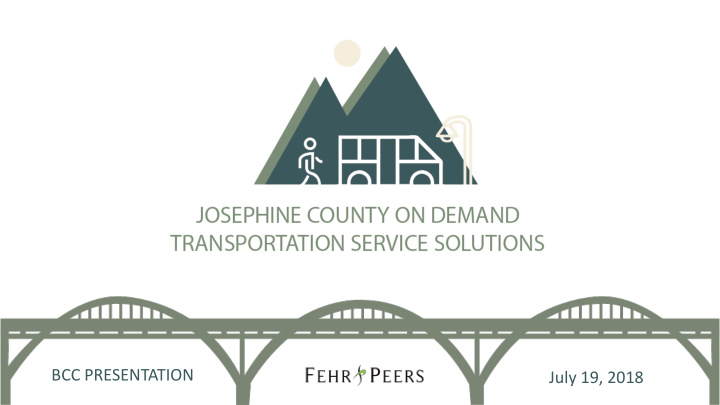



BCC PRESENTATION July 19, 2018
TABLE OF CONTENTS . 1 What is On Demand Service? 2 Background Analysis 3 Operations Plan 4 Marketing Plan 5 Evaluation Plan
What is On Demand Service? A modified version of public transit that is an efficient solution to complement the existing services in the region and expand affordable mobility options. Small to medium Door to door Flexible routing Shared rides Flexible sized vehicles service scheduling
Background Analysis
JCT Rider Survey
Existing Conditions: Demographics and the Built Environment Demographic Proximity Priority Score Priority Score Inputs Inputs - Population density - Schools - Employment - Parks density - Hospitals - Age (<18, >62) - Transit - Income proximity - Vehicle ownership - Other key - Non-ambulatory destinations
Existing Conditions: Current Travel Patterns
Literature Review • How can long-term risk be assessed and mitigated? • How does level of service provided by TNCs compare to transit agencies? • How can equity considerations be incorporated • Will this program reduce active modes? • Will on demand service take away from fixed route ridership?
CASE STUDIES
Public Outreach
Operations Plan
Service Types Point to Point Point to Point First Last Mile Daytime Evening • • • Connects any two points Connects any two points Trips between bus stops within JCT’s existing service and expanded service area within JCT’s existing • area service area Operates at same time as • • Operates after JCT service Operates at same time as JCT bus service (6:30am- ends (6:30pm-9:30pm) 6:30pm) JCT bus service (6:30am- • • Extends the operating 6:30pm) Extends the range of • hours of existing transit existing transit service Connects points that are service not currently well- connected
Service Areas First-Last Mile Point to Point Service Area Service Area
Provider Models Transportation Network Company Josephine Community Transit Operated Operated In-house operations where JCT A TNC is a company or leases/purchases additional fleet organization that provides rides vehicles and operate them by pairing passengers with through their own labor pool or a independent drivers via websites contracted third party or apps
Provider Comparison
Pilot Characteristics Average of 15 mins, $2 Point to point Smartphone Concierge $1 First-last mile maximum 30 mins Fare Wait time Booking User registration Geofence FLM: bus stop User/day Integrated Both providers have Smartphone Cash start/end trip cap fare card ADA vehicles Enforcement Payment ADA
Expected Ridership • Extrapolated transit ridership propensity from the existing fixed route system and service area to the proposed service areas by using: • StreetLight Data • On-board rider survey • Ridership data • Different assumptions used to determine a low and high bound First-Last Mile Point to Point (Daytime) Point to Point (Evening) Low High Low High Low High Annual riders (JCT fixed route 15,000 (+9%) 51,000 (+32%) 30,000 (+18%) 47,000 (+29%) 20,000 (+12%) 23,000 (+14%) boarding increase) Daily riders 58 205 119 188 79 91 Peak hour riders 5 16 9 15 35 40
Budget TNC-Operated Cost Inputs FLM P2P P2P evening Low $292,000 $399,000 $328,000 Total High $555,000 $524,000 $349,000 JCT-Operated Cost Inputs FLM P2P P2P evening Low $ 441,000 $ 585,000 $ 374,000 Total High $ 882,000 $ 837,000 $ 392,000
Economic Benefits Increased access to Travel time savings Increased transit Job creation jobs and services ridership First-Last Mile Point to Point (daytime) Point to Point (evening) JCT provider TNC provider JCT provider TNC provider JCT provider TNC provider Benefit/ High Low High Low High Low High Low High Low High Low Cost 0.80 1.58 0.56 1.65 0.97 2.35 0.67 2.85 0.64 1.12 0.37 0.89 Ratio
Implementation Funding: Federal, Phasing from Curbside Management Wayfinding State and Local year-long pilot to full implementation
Marketing Target audience: Low income Transit Elderly RCC attendees Youth dependent An increased budget for marketing will contribute to the Branding building off JCT Outreach and success of the pilot Promotion
Evaluation Important to measure Collect key data points and track the success from provider of the pilot Goal Performance Measure Data Conduct surveys to all users
Thank you fo for you r your r tim time. For more information, please contact: Scott Chancey Carly Sieff Transit Program Supervisor Fehr & Peers Josephine Community Transit 720.457.6370 541.474.5441 C.Sieff@fehrandpeers.com schancey@co.josephine.or.us
Recommend
More recommend